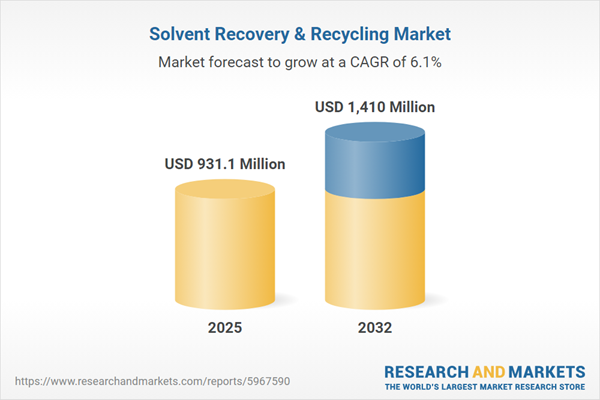Speak directly to the analyst to clarify any post sales queries you may have.
Solvent recovery and recycling are now fundamental to industrial sustainability strategies, empowering organizations to achieve cost efficiencies and meet environmental objectives. These capabilities help drive circular operations, minimize waste, and meet tightening compliance standards.
Market Snapshot: Solvent Recovery & Recycling Market
The Solvent Recovery & Recycling Market grew from USD 880.64 million in 2024 to USD 931.10 million in 2025. It is expected to continue expanding at a CAGR of 6.09%, ultimately reaching USD 1.41 billion by 2032. This growth is underpinned by multi-sector adoption and stricter regulations worldwide. The market’s momentum reflects the increasing need for effective solvent management solutions across production environments.
Scope & Segmentation: Comprehensive Market Understanding
- Type: Alcohols, Aliphatic Solvents, Aromatic Solvents, Chlorinated Solvents, Esters, Ketones
- Technology: Adsorption, Centrifugation, Distillation, Evaporation, Membrane Filtration
- Type of Recovery System: Off-site Recovery Systems, On-site Recovery Systems
- End-Use Industry: Automotive, Chemical Manufacturing, Cosmetics & Personal Care, Food & Beverage, Oil & Gas, Pharmaceuticals
- Geographic Coverage: Americas (United States, Canada, Mexico, Brazil, Argentina, Chile, Colombia, Peru), Europe, Middle East & Africa (United Kingdom, Germany, France, Russia, Italy, Spain, Netherlands, Sweden, Poland, Switzerland, United Arab Emirates, Saudi Arabia, Qatar, Turkey, Israel, South Africa, Nigeria, Egypt, Kenya), Asia-Pacific (China, India, Japan, Australia, South Korea, Indonesia, Thailand, Malaysia, Singapore, Taiwan)
- Company Analysis: Absolute Solvents Ltd., Best Technology Inc., Brofind S.p.A., CLEAN HARBORS, INC., CleanPlanet Chemical, Dalal Engineering, Eastman Kodak Company, Enviro-Safe Resource Recovery, Gage Products Company, Hydrite Chemical Co., Indaver, Innovative Recycling, JACOBI CARBONS GROUP, KIMURA CHEMICAL PLANTS CO., LTD., KOBEX Co.,Ltd., Koch-Glitsch, LP, LyondellBasell Industries Holdings B.V., Maratek Environmental Inc., Mitsubishi Chemical Corporation, NexGen Enviro Systems Inc., OFRU Recycling, Patvin Engineering Pvt. Ltd, PRI Systems, Rutpen Ltd., Solutex Ltd., Solvay S.A., Thermo Fisher Scientific Inc., Veolia Environnement S.A.
Key Takeaways for Senior Decision-Makers
- Rising regulatory scrutiny and sustainability mandates are making solvent recovery a core operational requirement for industries looking to align with circular economy principles.
- Digital monitoring and predictive maintenance tools are increasingly embedded into recovery systems, supporting real-time optimization and robust compliance management.
- Companies capable of deploying on-site recovery systems gain significant competitive and operational advantages by reducing dependencies on global supply chains.
- The diverse needs of end-use industries—from the purity demands of food and pharmaceuticals to the volume flexibility for automotive and chemical manufacturers—drive tailored solution adoption.
- Strategic collaborations between technology providers, manufacturers, and regulatory bodies foster rapid innovation and accelerate the rollout of advanced recovery methods.
Tariff Impact: Adjusting to New Trade Dynamics
Recent United States tariff policies have reshaped supply chains across the solvent recovery sector. Increased duties on imported feedstocks and specialized equipment are prompting organizations to consider nearshoring, local production, and alternative sourcing strategies. Domestic suppliers and those with flexible supply agreements are better positioned to adapt as costs and trade flows shift, reinforcing the importance of agile procurement and resilient supply chain structures.
Methodology & Data Sources
This market insight is based on a hybrid research approach that combines in-depth interviews with industry experts, thorough review of technical journals and regulatory publications, and quantitative validation using scenario analysis. The resulting data are cross-checked through peer review to deliver accurate and actionable intelligence.
Why This Report Matters
- Supports informed investment and innovation decisions by outlining the interplay of regulation, technology, and regional market dynamics.
- Offers strategic direction for deploying advanced recovery systems and adapting to evolving compliance landscapes.
- Helps senior leaders identify new partnership and growth opportunities within a rapidly evolving industrial segment.
Conclusion
Effective solvent recovery will remain central to operational resilience and sustainability goals. Using the insights and solutions outlined in this research helps organizations anticipate regulatory shifts and unlock value across global operations.
Additional Product Information:
- Purchase of this report includes 1 year online access with quarterly updates.
- This report can be updated on request. Please contact our Customer Experience team using the Ask a Question widget on our website.
Table of Contents
3. Executive Summary
4. Market Overview
7. Cumulative Impact of Artificial Intelligence 2025
Companies Mentioned
The companies profiled in this Solvent Recovery & Recycling market report include:- Absolute Solvents Ltd.
- Best Technology Inc. ·
- Brofind S.p.A.
- CLEAN HARBORS, INC.
- CleanPlanet Chemical
- Dalal Engineering
- Eastman Kodak Company
- Enviro-Safe Resource Recovery
- Gage Products Company
- Hydrite Chemical Co.
- Indaver
- Innovative Recycling
- JACOBI CARBONS GROUP
- KIMURA CHEMICAL PLANTS CO., LTD.
- KOBEX Co.,Ltd.
- Koch-Glitsch, LP
- LyondellBasell Industries Holdings B.V.
- Maratek Environmental Inc.
- Mitsubishi Chemical Corporation
- NexGen Enviro Systems Inc.
- OFRU Recycling
- Patvin Engineering Pvt. Ltd
- PRI Systems
- Rutpen Ltd.
- Solutex Ltd.
- Solvay S.A.
- Thermo Fisher Scientific Inc.
- Veolia Environnement S.A.
Table Information
| Report Attribute | Details |
|---|---|
| No. of Pages | 197 |
| Published | November 2025 |
| Forecast Period | 2025 - 2032 |
| Estimated Market Value ( USD | $ 931.1 Million |
| Forecasted Market Value ( USD | $ 1410 Million |
| Compound Annual Growth Rate | 6.0% |
| Regions Covered | Global |
| No. of Companies Mentioned | 29 |









